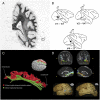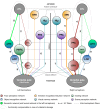Functional Anatomy of the Inferior Longitudinal Fasciculus: From Historical Reports to Current Hypotheses
- PMID: 30283306
- PMCID: PMC6156142
- DOI: 10.3389/fnana.2018.00077
Functional Anatomy of the Inferior Longitudinal Fasciculus: From Historical Reports to Current Hypotheses
Abstract
The inferior longitudinal fasciculus (ILF) is a long-range, associative white matter pathway that connects the occipital and temporal-occipital areas of the brain to the anterior temporal areas. In view of the ILF's anatomic connections, it has been suggested that this pathway has a major role in a relatively large array of brain functions. Until recently, however, the literature data on these potential functions were scarce. Here, we review the key findings of recent anatomic, neuromodulation, and neuropsychological studies. We also summarize reports on how this tract is disrupted in a wide range of brain disorders, including psychopathologic, neurodevelopmental, and neurologic diseases. Our review reveals that the ILF is a multilayered, bidirectional tract involved in processing and modulating visual cues and thus in visually guided decisions and behaviors. Accordingly, sudden disruption of the ILF by neurologic insult is mainly associated with neuropsychological impairments of visual cognition (e.g., visual agnosia, prosopagnosia, and alexia). Furthermore, disruption of the ILF may constitute the pathophysiologic basis for visual hallucinations and socio-emotional impairments in schizophrenia, as well as emotional difficulties in autism spectrum disorder. Degeneration of the ILF in neurodegenerative diseases affecting the temporal lobe may explain (at least in part) the gradual onset of semantic and lexical access difficulties. Although some of the functions mediated by the ILF appear to be relatively lateralized, observations from neurosurgery suggest that disruption of the tract's anterior portion can be dynamically compensated for by the contralateral portion. This might explain why bilateral disruption of the ILF in either acute or progressive disease is highly detrimental in neuropsychological terms.
Keywords: emotion recognition; inferior longitudinal fasciculus; lexical retrieval; prosopagnosia; reading; semantics; ventral pathway; visual agnosia.
Figures


Similar articles
-
The inferior longitudinal fasciculus: anatomy, function and surgical considerations.J Neurosurg Sci. 2021 Dec;65(6):590-604. doi: 10.23736/S0390-5616.21.05391-1. Epub 2021 May 3. J Neurosurg Sci. 2021. PMID: 33940783 Review.
-
Deficits in naming pictures of objects are associated with glioma infiltration of the inferior longitudinal fasciculus: A study with diffusion MRI tractography, volumetric MRI, and neuropsychology.Hum Brain Mapp. 2023 Jul;44(10):4011-4027. doi: 10.1002/hbm.26325. Epub 2023 May 5. Hum Brain Mapp. 2023. PMID: 37145980 Free PMC article.
-
Inferior Longitudinal Fasciculus' Role in Visual Processing and Language Comprehension: A Combined MEG-DTI Study.Front Neurosci. 2019 Aug 23;13:875. doi: 10.3389/fnins.2019.00875. eCollection 2019. Front Neurosci. 2019. PMID: 31507359 Free PMC article.
-
Does the left inferior longitudinal fasciculus play a role in language? A brain stimulation study.Brain. 2007 Mar;130(Pt 3):623-9. doi: 10.1093/brain/awl361. Epub 2007 Jan 29. Brain. 2007. PMID: 17264096
-
Disruption of Inferior Longitudinal Fasciculus Microstructure in Parkinson's Disease: A Systematic Review of Diffusion Tensor Imaging Studies.Front Neurol. 2018 Jul 26;9:598. doi: 10.3389/fneur.2018.00598. eCollection 2018. Front Neurol. 2018. PMID: 30093877 Free PMC article. Review.
Cited by
-
Structural white and gray matter differences in a large sample of patients with Posttraumatic Stress Disorder and a healthy and trauma-exposed control group: Diffusion tensor imaging and region-based morphometry.Neuroimage Clin. 2020;28:102424. doi: 10.1016/j.nicl.2020.102424. Epub 2020 Sep 12. Neuroimage Clin. 2020. PMID: 32977211 Free PMC article.
-
Altered White Matter Integrity in Patients with Retinal Vein Occlusion: A Diffusion Tensor Imaging and Tract-Based Spatial Statistics Study.Dis Markers. 2022 Feb 24;2022:9647706. doi: 10.1155/2022/9647706. eCollection 2022. Dis Markers. 2022. PMID: 35251379 Free PMC article.
-
Increased functional connectivity of white-matter in myotonic dystrophy type 1.Front Neurosci. 2022 Aug 1;16:953742. doi: 10.3389/fnins.2022.953742. eCollection 2022. Front Neurosci. 2022. PMID: 35979335 Free PMC article.
-
Microstructural alterations predict impaired bimanual control in Parkinson's disease.Brain Commun. 2022 May 22;4(3):fcac137. doi: 10.1093/braincomms/fcac137. eCollection 2022. Brain Commun. 2022. PMID: 35702729 Free PMC article.
-
Secondary neurodegeneration following Stroke: what can blood biomarkers tell us?Front Neurol. 2023 Sep 1;14:1198216. doi: 10.3389/fneur.2023.1198216. eCollection 2023. Front Neurol. 2023. PMID: 37719764 Free PMC article. Review.
References
-
- Albert M. L., Soffer D., Silverberg R., Reches A. (1979). The anatomic basis of visual agnosia. Neurology 29 876–876. - PubMed
Publication types
LinkOut - more resources
Full Text Sources

